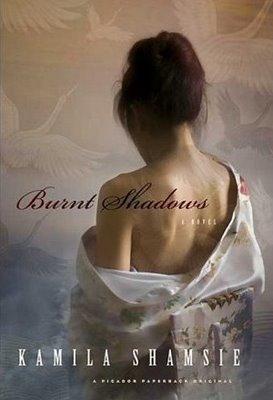Burnt Shadows

Kamila Shamsie’s latest novel, Burnt Shadows, is a well crafted story, centering on the life of a fierce and feisty Japanese woman named Hiroko. The novel spans four historical world events as we witness Hiroko’s navigation through tragedy, love, family, and identity.
Beginning in Nagasaki, Japan on August 9, 1945, we first meet the smart and talented schoolteacher Hiroko and soon learn that she is in love with Konrad, a German man that she is helping to translate texts. As their conversations flow between Japanese, English, and German, Konrad eventually asks Hiroko to marry him. Their giddy love for each other grows within the seconds that Hiroko agrees to marry him, but Konrad has to leave her house to run an errand. Still tingling with excitement, Hiroko puts on her mother’s silk kimono with three black cranes on the back of it and within seconds those birds will remain engraved on her body forever. As the second atomic bomb is dropped on Nagasaki, the world for Hiroko turns deathly white, and the love of her life will never be seen again.
It is from this moment on that the rest of the novel unfolds. With her bird-scarred body and a huge hole in her heart from the death of Konrad and her father, Hiroko travels to India in search of Konrad’s sister, Elizabeth Burton—someone who can help Hiroko keep the memory of Konrad alive. The year is 1947, and as Hiroko seeks to find more of herself in India, while still remembering her home country, India is a shifting landscape on the brink of war. Entering into the second historical event of the novel, Shamsie introduces many deep and emotionally rich characters that reveal the complexities of Partition.
In India, Hiroko meets Sajjad—a man who is paid by the Burtons to assist them with whatever they need, but he is more to them than a lower-class servant. When Sajjad and Hiroko discover they both have a love for languages, they begin to have informal language classes. The energy that flows between them in every language they converse in is overwhelming in the best way, and the unlikely pair of the displaced Japanese woman and Muslim Indian man eventually marries. Shamsie’s development of Hiroko’s character during this time is beautiful. Dealing with issues of grief—both for her lost fiancé and family, as well as for her home country that now feels lost to her—and her unfaltering desire to always be an emotionally strong woman, Hiroko emerges from this section of the novel with a resilience that carries her throughout the rest of the story.
The third part of the novel begins with Hiroko and her husband Sajjad sitting at their kitchen table with their son Raza. The time and place is Pakistan in 1982. Raza is an intelligent young man who enjoys doing multi-lingual crosswords—an outcome of having a Japanese mother who speaks at least four languages and an Indian father who speaks multiple languages himself. Raza is a stunning mixture of his heritage, and both his mind and physical body hold this history. As Raza grows into young adulthood he is increasingly mistaken for an Afghan, which becomes both a blessing and a curse.
The Soviet invasion of Afghanistan is the third political event that Shamsie uses as a backdrop for her story. While the narrative concentration of the novel switches from Hiroko to Raza, the story continues to take on the issues of identity that helped to construct the reader’s relationship with Hiroko. Without giving away too much of the story, it is Raza’s need to find his identity that ultimately results in another huge life change for Hiroko.
Finally, it is 2001, and Hiroko is in New York City post-9/11. Raza finds himself in a dangerous situation in Afghanistan and the climax of the novel results in Raza trying to get to America to see his mother one last time. Interspersed throughout this story are characters that represent different historical times and locations. Like memories, they pop back up in the story to enrich and inform life.
While Burnt Shadows is rich with historical content and events, Shamsie’s thoughtful storytelling humanizes each situation. In the end, the reader is incredibly well taken care of. Shamsie is an expert at crafting a story in which the characters and setting help to create each other. Time, location, identity, and humanness can never be separated as single characteristics of the novel, but instead swell together to create an unforgettable journey.